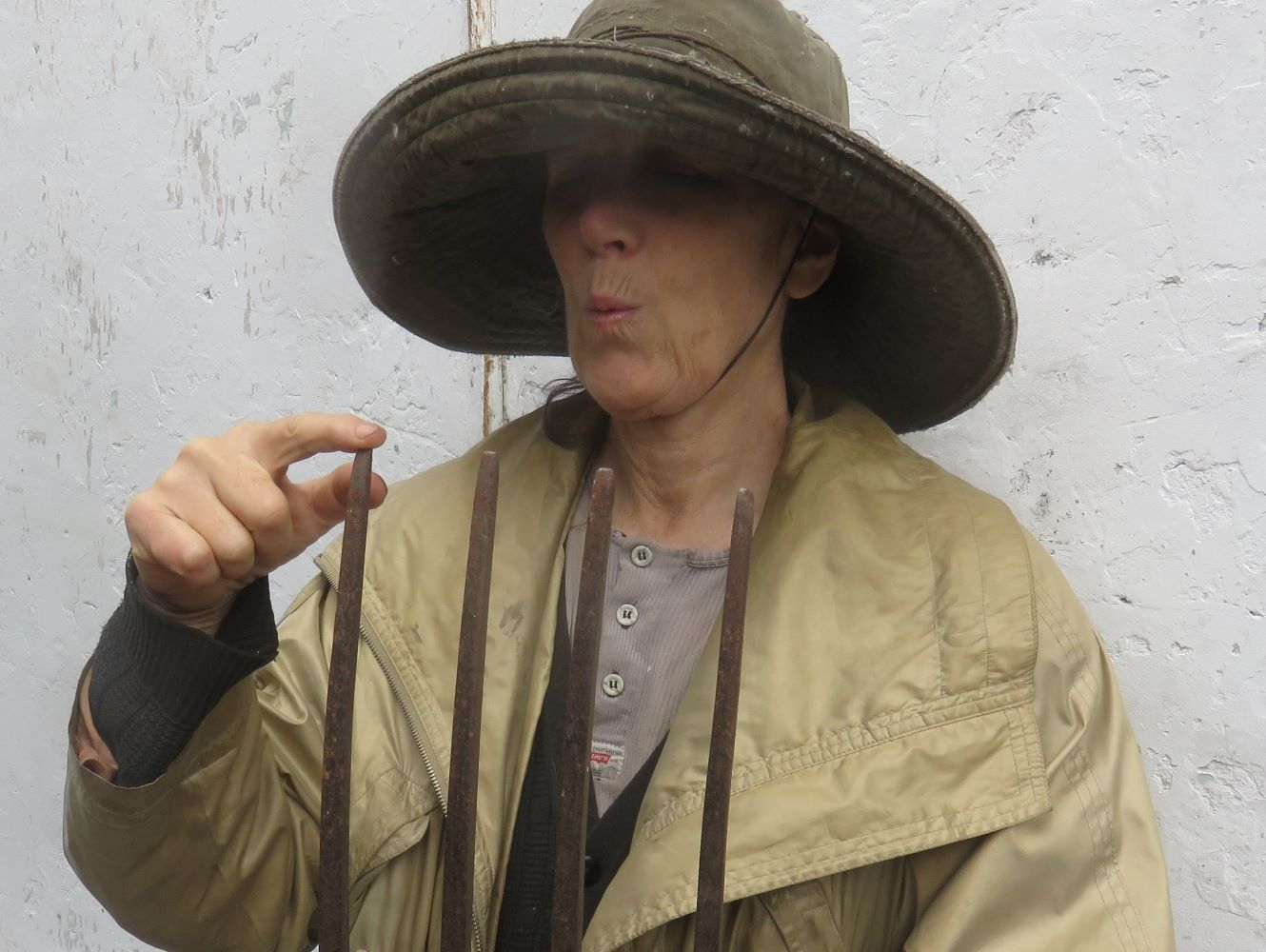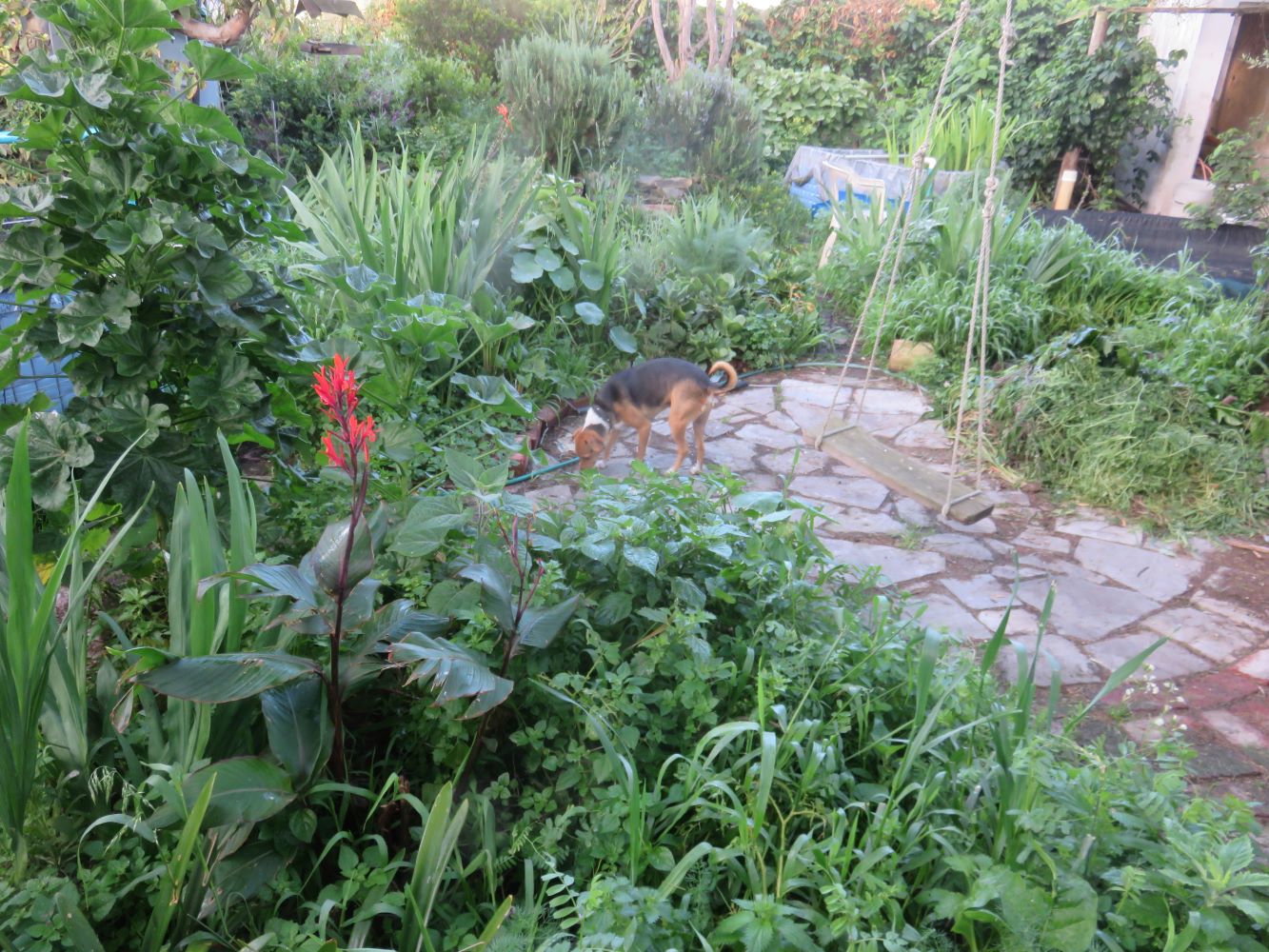Dear Reader, in this age of AI created content, please support with your goodwill someone who works harder to provide the human-made. Sign up in the righthand column or bottom of this page. You will receive my hand illustrated monthly newsletter RESTORE NATURE and access to the biodiversity garden design course as I write...and nothing else, I respect your time.
How to do regenerative farming on a micro scale
 Ouch ! Digging implements hurt the ground too. Apply regenerative farming principles.
Ouch ! Digging implements hurt the ground too. Apply regenerative farming principles.Applying regenerative farming principles to intensive growing
If you are an organic grower or gardener you may be doing regenerative practice already. But maybe not all your practices. If you wish to switch to regenerative practice apply the 5 regeneration principles, and fill the gaps in your practice if there are any.
In order of importance for gardening: Cover your soil, all of it, all the time, minimal disturbance, leave living roots in the soil for as long as possible, plant diversity, integrate animals.
The principle of minimal disturbance refers to both mechanical and chemical interference. Therefore regenerative practice minimizes digging, ploughing, chemical fertilizers and biocides both synthetic and organic.
I've seen vegetable growers rolling their eyes at this in the past, believing it is impossible, but actually its just a matter of tweaking or applying properly the batch of tools used by some very successful market gardeners. If you are growing vegetables, French intensive or biointensive actually applies
many of the regenerative principles. But we have to emphasize, not all. It is those few points of difference which must be adjusted to become fully regenerative.
French intensive or biointensive growing uses many ancient techniques found in China, Africa and Meso America. But not all ancient growing methods were a hundred percent good. Great deserts were created by human agriculture and animal husbandry thousands of years ago in north Africa, the middle east and China using fully organic methods, as they had no synthetic chemicals then. A few adjustments to ancient vegetable growing practice is all that is needed. The greater mass of ancient knowledge, on how to save seed, and how to plant, with what and when is precious and makes up a huge part of the skill set.
I am not much of a grower, with little experience, but I've spent a few months doing this under a master and I've seen plenty of accounts that it works. Biointensive farming applies the regenerative farming principles in the following manner, starting from the bottom, literally.
Integrate animals
Biointensive advocates composting your own human manure and applying it regularly to your soil. Use other manures too, the more different kinds the more microbial diversity you introduce. Biointensive uses a lot of composted plant material too, that contains another set of microbes. The more diverse your soil microbiome, the more it can protect plant roots against pathogens.
Plant diversity
Use companion plantings, and as much diversity as possible, not just in sequence, but at the same time. With enough simultaneous diversity even sequential diversity, or crop rotation may be less needed.
Leave living roots in the soil as long as possible
Some root crops may be left to decompose in the soil in French intensive. Between crops you can cut back rather than ripping out the plants.
No disturbanceFrench intensive methods will not employ synthetic chemicals of course, but they do use natural poisons. These plant poisons affect a range of insects, not just the pests, and using them decreases insect diversity. Any biocide is a killer, whether it comes from a plant or not.
Bio intensive farming will also use double digging. These would be the only major differences with regenerative practice. Note that in French intensive double digging, the bottom layer (of the double) is only pricked with a fork. It is not turned, and then the soil is surface tilled only to three inches for many seasons.
Some successful market gardeners have abandoned digging, and some maize farmers abandoned ploughing to find that their soil improves in all the positive soil attributes. No dig methods can actually increase your soil's water and nutrient absorption and retention and improve structure.
Digging implements break mycelial threads and soil aggregates which are the essence of good soil structure and bring all the positive attributes of living soil. Digging also disturbs microbial communities, decimating some in the sunlight and starving others of oxygen as the soil is turned.
Double digging to loosen soil is only necessary when you, or a past user of your soil, have destroyed your soil life and the soil structure has collapsed and compacted.
Keep the soil covered
Total soil cover can be achieved in many ways with the bio intensive methods like the following:
French intensive keeps the soil covered by planting close enough for the vegetables to form a canopy so that the soil is never heating up, drying out or exposed to wind. Rather than being far apart with naked soil between, the tips of the leaves must just touch. This will mean your soil is shaded and at least thirty degrees cooler. You will use less water, have fewer weeds, and your soil biology continues to thrive and build more beautiful living soil !
Planting is at least four times denser than traditional row planting with triangular or hexagonal spacing rather than rows.
Companion planting for nutrient and chemical compatibility using natural 'friends'.
Companion planting using differing heights of plants in the same space, to use all the space, and keep the soil covered with low ground cover crops.
Replacing harvested plants immediately with waiting seedlings. You need to keep nutrient needs and crop rotation succession in mind.
Filling all gaps in the garden with new seedlings.
Regenerative farming is not easy on the brain !
I was in training with a permaculture gardener at one stage who applied all these biointensive planting techniques, that are also actually super regenerative. Working out what to plant where, with what and when to sow replacements required the memory and ability for complex thinking of a computational genius. I was not up to it, and I'm in total awe of regenerative vegetable growers who are totally planted up all the time. Many years of experience will give one a modus operandi with tricks that overcome the cognitive load. It is precious knowledge and all over the world it is being lost.
Bio intensive growing can be more destructive than Big Ag !
There is a caveat with biointensive methods. Because these techniques can lead to very high yields, there is greater danger of rapid soil exhaustion, even worse than the degradation of conventional chemical farming, according to the wiser practitioners of the art.
Goal differences between bio intensive and regenerative growing
One goal of the biointensive method is
sustainability, that is things should remain as they are, without
degeneration. Biointensive methods must be applied in full, say the experts, or rapid
degradation can follow. Soil cover is part of that suite of practices.
But even the wonderfully sustainable biointensive practices have room for improvement.
The goal of
regenerative gardening is not to maintain, but to increase soil health,
biodiversity and the fertility of the land and continue to increase it in an ever growing upward spiral of positive feedback loops.
This is the ultimate mind set difference, and why all damaging practices
are abandoned in regenerative farming, despite the short term gains. Untilled and diversely planted soil takes about
ten years to overtake tilled soil in productivity, and after that it
just keeps going, getting better and better. This is a form of gardening for the long haul, for
your grandchildren.
To truly nurture the soil, some major shifts are needed in ancient, time tested agricultural and gardening practices. Remember, natural farming methods over the millennia have created many of our deserts. So natural is not enough. Adding dead organic matter like compost and manure is good. But its not the only way to nurture soil life, and it needs to be added over and over and over, because it will oxidize and disappear with time. Plants, specifically in the root zone, are far more effective than compost and manure at nurturing soil life. If you plant cleverly, for maximum soil health, making the right plant choices and keeping plant roots and their fabulous microbiome in the ground consistently, you can eventually ditch the other organic amendments and the plants will do all the work for you.
The problem with "Euroveg"
We also have to change the kind of food we eat and grow because our diet is based on fast seed to harvest annuals bred for the short growing season in the northern hemisphere, it really is, especially here in South Africa. We are food colonized. These plants need a lot of feeding and water, and are not content with our native soils.
What I call 'Euroveg' creates an unsustainable work load for employed people and unnatural nutrient requirements within the context of our Cape environment. The short growing season also means we pull out the old plants and plant new ones at least once a year, usually twice. This replacement activity is very destructive to the soil microbes.
Dryland crops like wheat are the epitome of Euroveg's diversity reduction and are desertifying the Swartland and Overberg. We need to eat less wheat for our own health and for the environment, and we need activism to stop the destruction in these areas.
Because of the bad impact of Euroveg, people who teach how to prepare indigenous foods are at the forefront of saving the soils of the world for the future.
We should aim for eating more leafy greens, tend to root vegetables rather than grains for calories, and wherever possible, using the plants of the southern hemisphere that grow more slowly and stay in the soil longer, and wherever possible, using perennial plants, and wherever possible indigenous plants that love our soils. If we make sure our soil is covered, always, and wherever possible covered with plants rather than dead organic matter like straw, and we are informed and focused on the soil microbiome, rather than short term productivity, we can grow food regeneratively.
------
home page for links to all my topics on regenerative and restorative gardening techniques
------
greenidiom's regenerative gardening blog
------
------
Restore Nature Newsletter
I've been writing for four years now and I would love to hear from you
Please let me know if you have any questions, comments or stories to share on gardening, permaculture, regenerative agriculture, food forests, natural gardening, do nothing gardening, observations about pests and diseases, foraging, dealing with and using weeds constructively, composting and going offgrid.
SEARCH
Order the Kindle E-book for the SPECIAL PRICE of only
Prices valid till 30.09.2023
Recent Articles
-
garden for life is a blog about saving the earth one garden at a time
Apr 18, 25 01:18 PM
The garden for life blog has short articles on gardening for biodiversity with native plants and regenerating soil for climate amelioration and nutritious food -
Cape Flats Sand Fynbos, Cape Town's most endangered native vegetation!
Apr 18, 25 10:36 AM
Cape Flats Sand Fynbos, a vegetation type found in the super diverse Cape Fynbos region is threatened by Cape Town's urban development and invasive alien plants -
Geography Research Task
Jan 31, 25 11:37 PM
To whom it may concern My name is Tanyaradzwa Madziwa and I am a matric student at Springfield Convent School. As part of our geography syllabus for this
"How to start a profitable worm business on a shoestring budget
Order a printed copy from "Amazon" at the SPECIAL PRICE of only
or a digital version from the "Kindle" store at the SPECIAL PRICE of only
Prices valid till 30.09.2023







